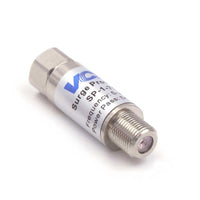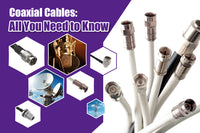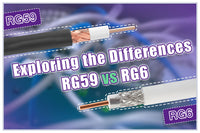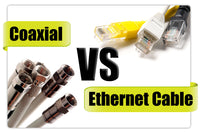Compared to fiber or ethernet cables, traditional coaxial cables are not entirely obsolete and still have their place in cable modem applications. The F-type connector is a specific type of coaxial connector that is often used to connect coaxial cables to your domestic TV applications, including cable, television, and satellite television. This article aims to enhance your understanding of F connectors, exploring their features, applications, and installations.
What is Coaxial Connector?
Before knowing what an F connector is, it’s essential to know the concept of coaxial connector. Coaxial connectors, also known as coax connectors, are designed to terminate coaxial cables, which are cables with a central conductor, inner dielectric insulator, metallic shield, and an outer insulating layer. Coax connectors help transmit analog signals in high frequencies with minimal RF signal loss. They are widely used in RF, CATV, and microwave industries. Popular types of coaxial connectors include BNC, TNC, SMB, SMA, RCA, and F connectors. Among these connectors, F connectors for coaxial cables are the most cost-effective option for terminating coaxial cables in CATV and cable modems.
What is an F-Type Connector?
F-type connectors or F connectors were invented by Eric E. Winston in the early 1950s with the development of cable television. With the prevalence of their applications in VHF and UHF in the 1970s, they became one of the most common coaxial connectors in US domestic TVs.
The F-type connector has a 75 ohms impedance match and can support frequencies of up to 1 GHz. F-type connectors are often used with RG59 and RG6 cables in terrestrial, cable, and satellite TVs.
F Connector Gender
In the electrical field, coaxial connectors are usually divided into female and male types. They need to match correctly to facilitate the transmission of electrical signals in the correct direction.
By mating 3/8-32 United Extra Fine (UNEF) thread, coaxial F connectors have male and female types. The female F connector has an center socket inside surrounded by a threaded shell, while the male connector features a center pin and an internal thread. The female F connector is designed to precisely fit the corresponding male pin.
Types of F-Type Connectors
F-type connectors are typically categorized into three types based on different designs: twist-on, crimp-on, and compressed F connectors.
1. Twist-on/Screw-on F Connector

Among the three types of F connectors, twist-on F-type connectors are the easiest to install. They are reusable and can be directly screwed onto the coaxial cable, making them ideal for field termination. These connectors are widely applicable in over-the-air antennas thanks to their convenience and efficiency.
2. Crimp-on F connectors

The crimp-on F connector needs to be installed by using a special crimp tool to crimp the center pin It can provide great sealing if installed properly. But they are now replaced by compression F connectors.
3. Compression F Connectors

Compression F-type connectors also provide a strong seal but require a special tool for installation. By compressing the back end to the front end, these connectors can offer a waterproof and dustproof connection. It ensures high-quality signal integrity in many applications, such as surveillance systems, home theater systems, and so on.
Applications of F-Type Connectors
F-type connectors are widely used in different applications, including CATV, CCTV, board-to-board, and internet connection applications.
Television Applications: F connectors are widely used in television distribution systems, including cable television (CATV), satellite television (SATV), and Closed-Circuit Television (CCTV). These connectors connect coaxial cables from satellite or cable TV antennas to television set-top boxes.
Internet Access: F connectors can also be used to connect coaxial cables from internet service providers (ISPs) to the cable modem in your home or office for stable and reliable internet access.
Home Theater System: F-type connectors can also be used to connect antennas, cable TV feeds, and satellite dishes to home theaters.
How to Install an F-type Connector on Your Coaxial Cable?
How to correctly install the F connector on your RG59 or RG6 coaxial cables? We’ll guide you through the step-by-step process of installing a screw-on F-type connector onto the coaxial cable.
Step 1: Prepare the following materials and tools: an RG59 or RG6 coaxial cable, a screw-on F-type connector, and a wire stripper.
Step 2: Strip off about 1/2 inch of the jacket of the coaxial cable using a wire stripper.

Step 3: Strip off the insulation using the wire stripper to expose the center copper conductor. Make sure not to damage the conductor.

Step 4: Arrange the braided shielding.

Step 5: Slide the screw-on connector on the coaxial cable and twist it tightly.

Note: If you use a compression F connector, the installation process can be different. You should fit the F connector into the coaxial cable until it is fully seated, then insert the F connector in the compression tool, and press the tool tightly for a fully compressed F connector.
Final thoughts
F-type connectors provide a reliable connection for electrical signal transmission. It is still an essential component in transmitting analog or digital signals. Nowadays, this low-cost coaxial connector proves that simple and reliable designs are still enduring.
FAQs
What is the difference between F-type and N-type connectors?
F-type connectors are widely used for residential wiring such as cable television, satellite television, and cable modems; while N-type connectors are designed for commercial cables and are used for high-frequency (UHF) antennas and radios.
What are the differences between SMA and F-type connectors?
They are not the same. SMA connectors are 50-ohm coaxial connectors used in high-frequency applications for superior performance.
What are the disadvantages of the F connector?
Twist-on F connectors may cause signal loss. And crimp-on and compression F connectors can no longer be reused once installed.
For more information on this topic, you can keep up on our blogs. While VCELINK offers general and basic information for our customers and other visitors to the website, it’s not professional advice.






Be the first one to comment.
Leave a comment